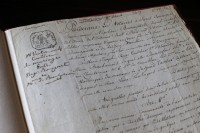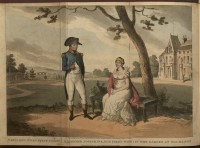 The day before Napoleon and Josephine’s wedding, the couple signed a marriage contract, but it wasn’t like a license you’d get from city hall. It takes a hard-nosed practical approach we’d recognize today as a prenuptial agreement, and quite a progressive one at that.
The day before Napoleon and Josephine’s wedding, the couple signed a marriage contract, but it wasn’t like a license you’d get from city hall. It takes a hard-nosed practical approach we’d recognize today as a prenuptial agreement, and quite a progressive one at that.
Article 1: There will be no community property between the future spouses. … Accordingly, the future spouses will not be liable for each other’s debts and mortgages.
Article 2: Each of the future spouses will enjoy separately and individually the property, rights and actions both movable and immovable belonging to them and that may belong to them thereafter in any capacity and any manner it is and in which it may consist. …The future wife will not be bound to seek her husband’s permission for acts that would entail the alienation of her capital. The future husband also authorizes the future wife to continue the functions of guardianship that have been granted her of the two minor children issue of her first marriage.
Article 3: Each of the future spouses will contribute half of the expenses of the marriage.
Article 4: The future husband establishes for the future wife a dowry of 1500 livres annuity for life, ancient value. …
Article 5: In case of dissolution of marriage, the future wife and her heirs reclaim: 1) clothes, linen, rags, lace, silver, jewelry and diamonds for the personal use of said future wife, 2) all the furniture and other movable objects and whatever type they be that the future wife or her heirs can prove were acquired by her or that otherwise belong to her.
Article 6: The future wife declares and the future husband recognizes that the furniture, linens, silverware and generally all the movable tangible assets of which the future wife is now in possession that was community property between her and her first husband and that continues with her children lack her having made an inventory within the time limit prescribed by law. That the future wife is to proceed to make this inventory and is about to be completed. That she, future wife, can not declare now the amount of this fortune because it all depends on the question of knowing if she will accept the community or whether she will renounce it, however she cannot determine that until after the making of the inventory.
 It seems that lack of inventory may have been a deliberate oversight on Josephine’s part. Without an itemized list, who’s to say which items she wanted to take should the marriage fall apart was community property from her first marriage? Then there’s the deception both spouses engaged in. Josephine was six years older than Napoleon and this was subject of some societal and familial tut-tutting, particularly on his family’s side. So in the official marriage contract, Napoleon is aged by one year and Josephine rejuvenated by four.
It seems that lack of inventory may have been a deliberate oversight on Josephine’s part. Without an itemized list, who’s to say which items she wanted to take should the marriage fall apart was community property from her first marriage? Then there’s the deception both spouses engaged in. Josephine was six years older than Napoleon and this was subject of some societal and familial tut-tutting, particularly on his family’s side. So in the official marriage contract, Napoleon is aged by one year and Josephine rejuvenated by four.
On the afternoon of March 8th, 1796 (18 Ventôse IV by the French Revolutionary Calendar), the marriage contract was signed by Napoleon Bonaparte, Chief of the Army of the Interior (he had already been appointed Chief of the Army of Italy on March 2nd, but the promotion didn’t take effect until March 11th, the day he left Paris with his army to invade Italy), and Rose Marie Josèphe Tascher, widow of Alexandre François Marie de Beauharnais. It was notarized by Maurice-Jean Raguideau de La Fosse and Étienne-Gabriel Jousset and witnessed by the future general and future count Jean-Léonor-François Le Marois, Napoleon’s aide-de-camp. On March 9th, 1796, Napoleon and Josephine were wed.
 The notary Raguideau reportedly thought this marriage was a terrible idea, not for Napoleon but for Josephine. This anecdote is from the questionably accurate Memoirs (Volume 2, Chapter XXIX) of Louis Antoine Fauvelet de Bourrienne, a diplomat and former schoolmate of Napoleon’s who served as his secretary shortly after the marriage.
The notary Raguideau reportedly thought this marriage was a terrible idea, not for Napoleon but for Josephine. This anecdote is from the questionably accurate Memoirs (Volume 2, Chapter XXIX) of Louis Antoine Fauvelet de Bourrienne, a diplomat and former schoolmate of Napoleon’s who served as his secretary shortly after the marriage.
When Bonaparte was paying his addresses to Madame de BEAUHARNAIS, neither the one nor the other kept a carriage; and therefore Bonaparte frequently accompanied her when she walked out. One day they went together to the notary Raguideau, one of the shortest men I think I ever saw in my life, Madame de Beauharnais placed great confidence, in him, and went there on purpose to acquaint him of her intention to marry the young general of artillery,—the protege of Barras. Josephine went alone into the notary’s office, while Bonaparte waited for her in an adjoining room. The door of Raguideau’s office did not shut close, and Bonaparte plainly heard him dissuading Madame de Beauharnais from her projected marriage. “You are going to take a very wrong step,” said he, “and you will be sorry for it, Can you be so mad as to marry a young man who has nothing but his cloak and his sword?” Bonaparte, Josephine told me, had never mentioned this to her, and she never supposed that he had heard what fell from Raguideau. “Only think, Bourrienne,” continued she, “what was my astonishment when, dressed in the Imperial robes on the Coronation day, he desired that Raguideau might be sent for, saying that he wished to see him immediately; and when Raguideau appeared; he said to him, ‘Well, sir! have I nothing but my cloak and my sword now?'”
Because both parties lied shamelessly, the contract would have been null-and-void had it ever seen the inside of an honest courtroom. Instead, when Napoleon tired of Josephine’s lovers, debts and her uterus’ insistence on not producing an heir, he divorced her. They had a formal divorce ceremony on January 10th, 1810, and although Napoleon married Marie Louise, Archduchess of Austria, just two months later, he and Josephine remained friends. Napoleon ordered that she retain the rank and title of empress, granted her full ownership of the Château de Malmaison and a pension of 5 million francs a year. She was at Malmaison when she died in 1814 while Napoleon was in exile on the island of Elba. Her name was the last word he spoke on his death bed in 1821.
There are two extant copies of Napoleon and Josephine’s prenup. Napoleon’s personal copy went to the National Archives because he didn’t have time to have it sent to him before his departure for Italy. Josephine’s copy, bound in a portfolio of rose morocco, has been in private hands for two centuries. It was sold at the Osenat auction house in Paris on September 21st. Three phone bidders drove the price from the €60,000 to €80,000 ($77,000 – $103,000) pre-sale estimate to a final cost including fees of €437,500 ($560,000).
The buyer was the Museum of Letters and Manuscripts, a privately-owned museum in Paris that bought Napoleon and Josephine’s divorce agreement from Osenat in 2007. Now they have the legal bookends of one of history’s greatest love stories.